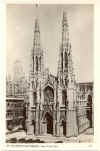 |
New York
Architecture Images- Midtown
St. Patrick’s Cathedral (RC) |
|
architect |
James Renwick Jr. and William Rodrigue |
|
location |
Fifth Avenue, bet. E50 and E51. |
|
date |
1851-79, towers 1888 |
|
style |
Gothic Revival |
|
construction |
stone |
|
type |
Church |
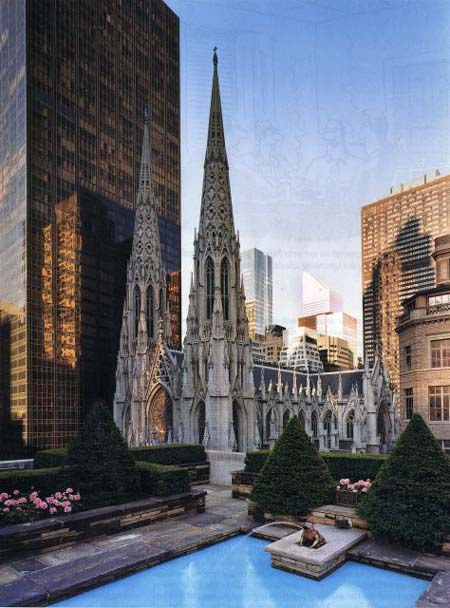 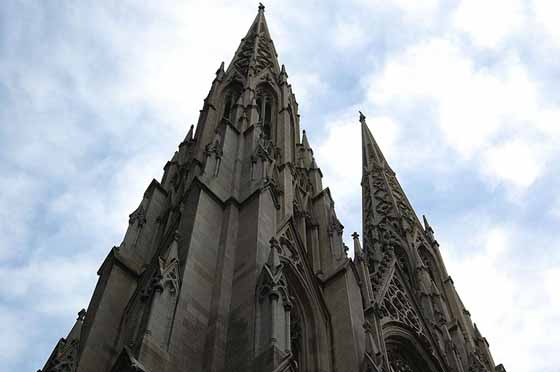 |
|
| Seen from the roofgarden of the British Empire Building. | |
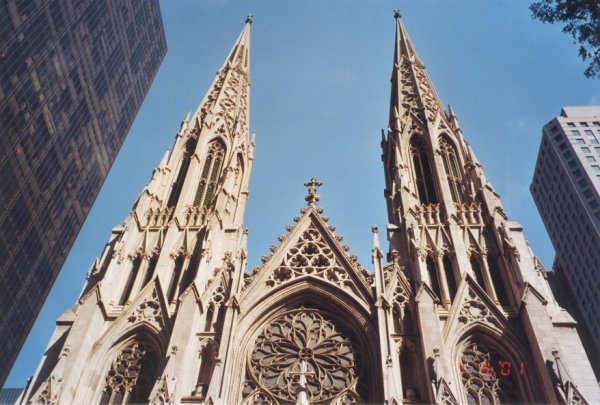 |
|
|
|
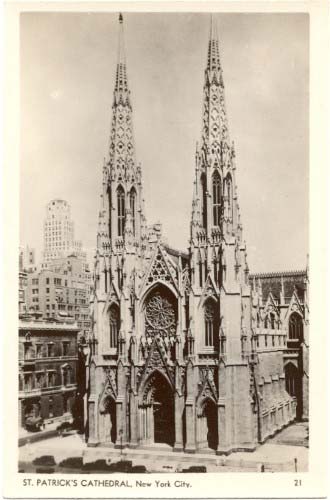 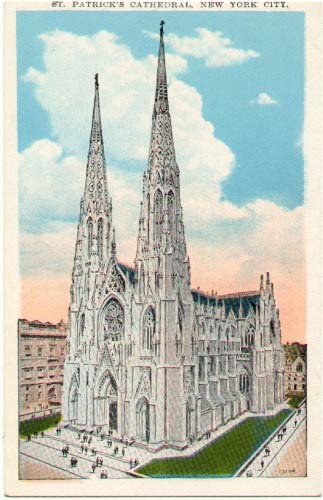 |
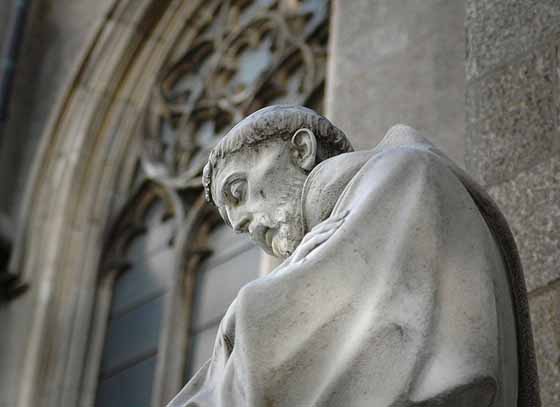 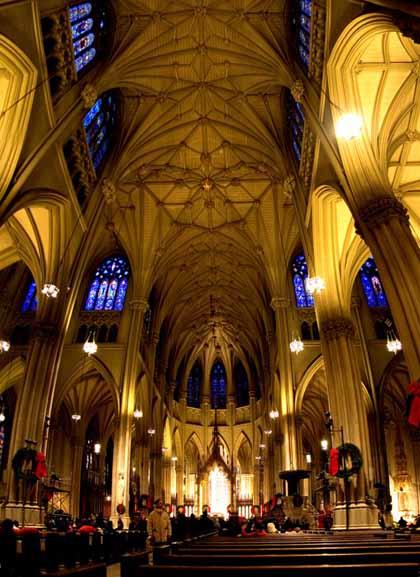 |
|
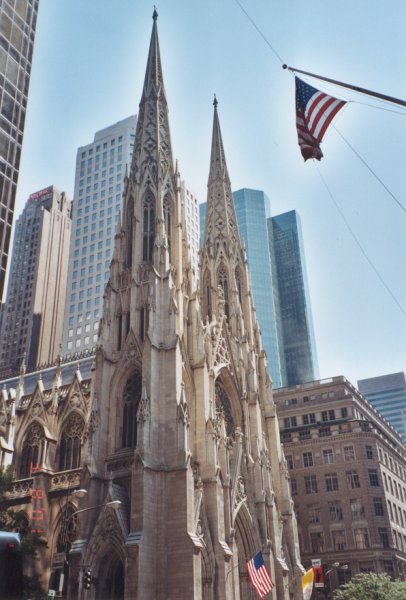 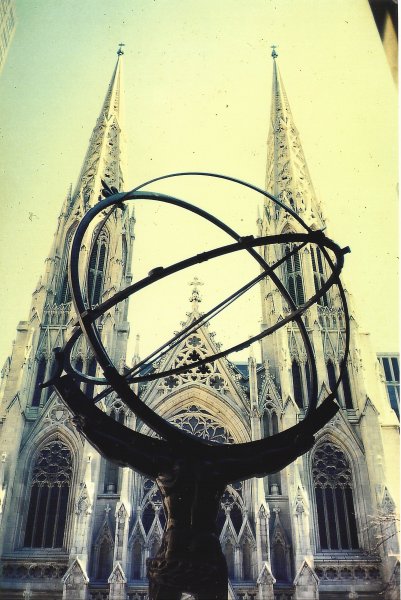 |
|
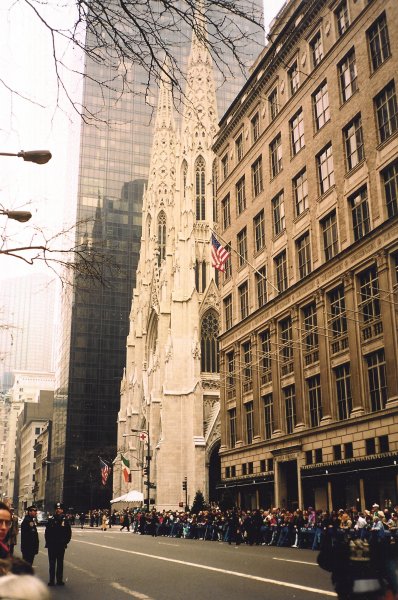 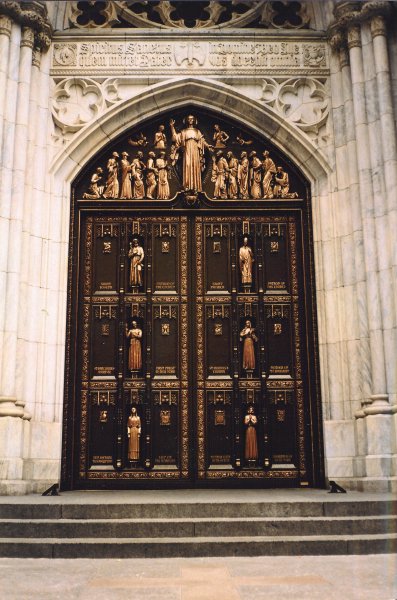 |
|
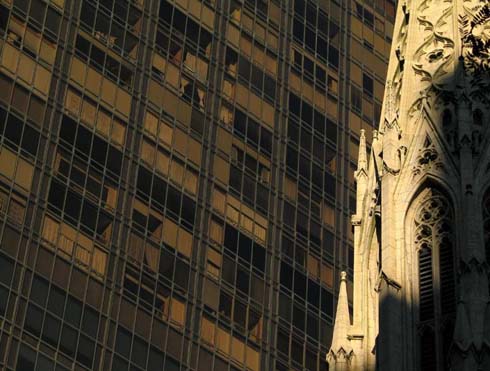 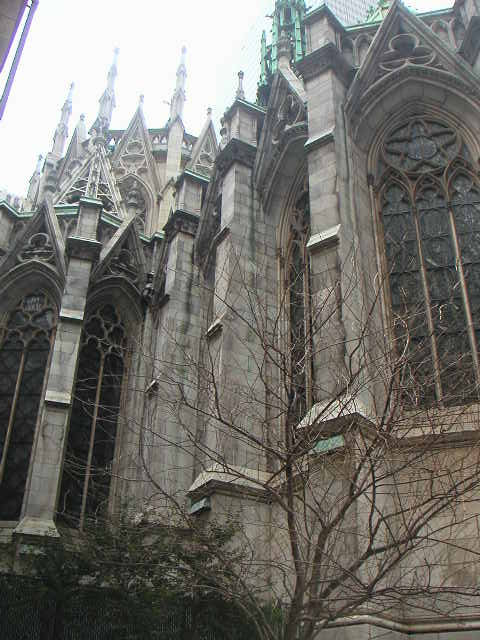 |
|
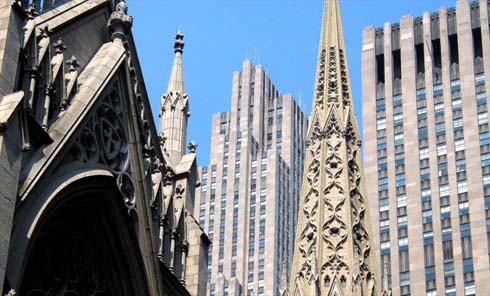 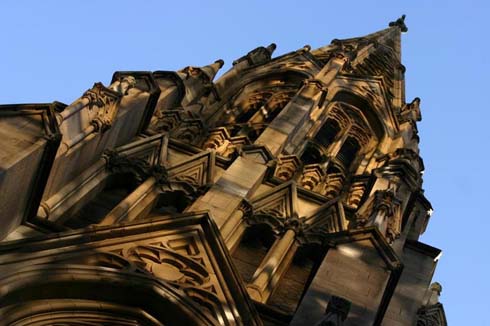 |
|
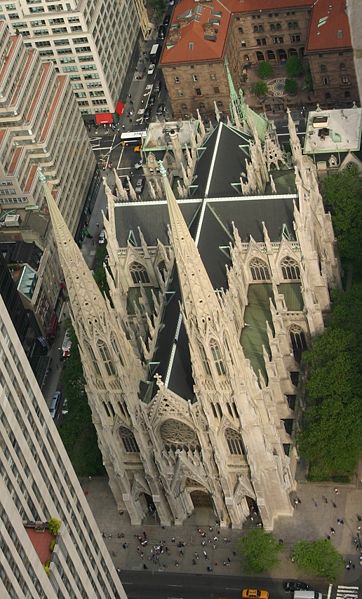
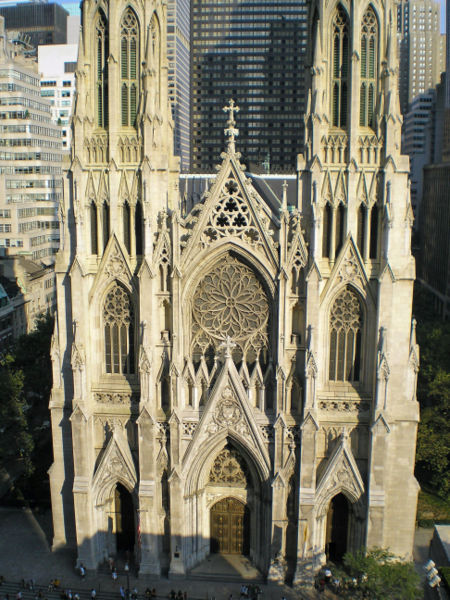 |
|
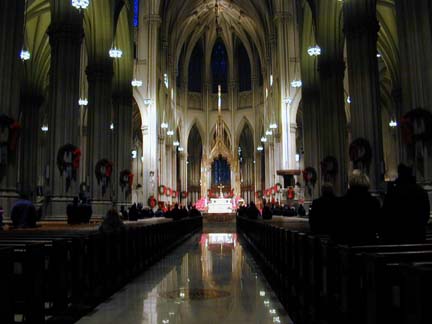 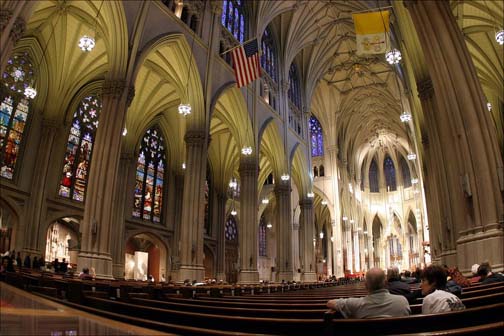 |
|
| St. Patrick's Cathedral is the largest decorated
Neo-Gothic-style Catholic cathedral in North America. It is the seat of the
archbishop of the Roman Catholic Archdiocese of New York, and a parish
church, located on Fifth Avenue between 50th and 51st streets in Manhattan.
It faces Rockefeller Center. History The site of the present cathedral was bought for $11,000 on March 6, 1810, as a site for a school for young Catholic men to be conducted by the Jesuits. This school failed, and in 1813 the land was sold again to Dom Augustin LeStrange, abbot of a community of Trappists (from the original monastery of La Trappe) who were in America fleeing persecution by French authorities. In addition to a small monastic community, they also looked after some 33 orphans. With the downfall of Napoleon in 1814, the Trappists returned to France, abandoning the property (the orphanage was maintained by the Diocese of New York into the late 1800s) — some of the monks traveled to Canada, however, and eventually founded St. Joseph's Abbey in Spencer, Massachusetts. The facade and 100 meters tall spires of the cathedral.The Diocese of New York, created in 1808, was made an archdiocese by Pope Pius IX on July 19, 1850. On October 6, 1850, Archbishop John Joseph Hughes announced his intention to erect a new cathedral to replace the Old St. Patrick's, located on the intersection of Prince and Mott Streets on Mulberry Street. The "Old Cathedral" had been destroyed by fire in 1866 but was rebuilt and rededicated by 1868. It is still a parish church and is the oldest Catholic site in New York City[citation needed]. The cornerstone for the new cathedral was laid on August 15, 1858, just south of the diocese's orphanage, much further north of the populous areas of New York at that time. The cathedral was designed by James Renwick, Jr. in the Gothic Revival style. Work was begun in 1858 but was halted during the American Civil War, commencing again in 1865. The cathedral was completed in 1878 and was dedicated on May 25, 1879, its huge proportions dominating the mid-town of that time. The archbishop's house and rectory were added from 1882 to 1884 and an adjacent school (no longer in existence) opened in 1882. The Towers on the West Facade were added in 1888, and an addition on the east, including a Lady Chapel, designed by Charles T. Mathews, began in 1901. The stained glass windows in the Lady Chapel were designed and made in Chipping Camden, England, by Paul Vincent Woodroffe between 1912-1930. The cathedral was renovated between 1927 and 1931, when the great organ was installed, and the sanctuary was enlarged. The cathedral and associated buildings were declared a National Historic Landmark in 1976.[1][2][3] Architectural features Detail of facade. The nave of the cathedralThe cathedral is built of white marble quarried in New York and Massachusetts. The parish is bound by 59th Street, 3rd Avenue, 44th Street, and 7th Avenue and can hold 2,200 people. The spires rise 330 feet (100 meters) from street level. The windows were made by artists in Chartres, Birmingham and Boston. The great rose window is one of Charles Connick's major works. The St. Michael and St. Louis altar was designed by Tiffany & Co.; the St. Elizabeth altar was designed by Paolo Medici of Rome. The Stations of the Cross won a prize for artistry at the World Columbian Exposition in Chicago in 1893. The pietà is three times larger than the Michelangelo's Pietà. A bust of Pope John Paul II is located in the rear of the cathedral, commemorating his visit to the city in 1979. Francis Spellman, then archbishop and later cardinal, undertook a major renovation of the main altar area of the cathedral in the late 1930s and early 1940s. The bronze baldachino in the sanctuary is part of this work, and the former high altar and reredos that stood there were removed and replaced. The original High Altar of St. Patrick's is now in the University Church of Fordham University at Rose Hill in the Bronx, N.Y. (Spellman's alma mater; coincidentally, that church, built in the 1830s, is also home to stained glass windows donated by King Louis Philippe of France for the "Old" Cathedral downtown when it was originally being built — they were used for the Bronx church when it was discovered that they did not fit in the original St. Patrick's.) Clendenin James Ryan donated the Rose window. In the 1980s, John Cardinal O'Connor undertook renovation work of his own, most notably the construction of a new stone altar in the middle of the sanctuary closer and more visible to the congregation. This was built from sections of one of the side altars that was removed to reposition the baptismal font in the north transept. The roof is made from slate from a relatively unknown town by the name of Monson. Organs The original pipe organs, built by George Jardine & Son in the 19th century, have been replaced. The Chancel Organ, in the north ambulatory, was made by the St. Louis firm of George Kilgen & Son, and installed in 1928. It has 3920 pipes. The Grand Gallery Organ, by the same company, was installed in 1930, and has 5918 pipes. [1] The combined organs, totaling 177 stops and 9838 pipes, can be played from either of two five-manual consoles installed in the early 1990s to replace the original Kilgen consoles. The current principal organist is Dr. Donald Dumler. Burials Sanctuary of the Cathedral. The bronze baldachino and the altar beneath it, both commissioned by Francis Cardinal Spellman, are visible in the rear. The very top of the altar commissioned by John Cardinal O'Connor, closer to the congregation, is visible in the lower left.The eight deceased archbishops of New York, six of them Cardinals, are buried in a crypt under the former high altar, visible from the entrance to the Lady Chapel in the rear of the cathedral. Four ceremonial hats of the cardinals, called galeros, are suspended from the ceiling, high above the back of the sanctuary. Cardinal Spellman's hat was the one worn by Pope Pius XII when he was a cardinal. The others of those of Cardinals McCloskey, Farley, and Hayes. In 1967, the ceremony of the consistory was revised by Pope Paul VI and therefore no galero was presented to Cardinal Cooke or any of his successors. Pierre Toussaint helped pay for the reconstruction of old St. Peter's Church (the first Catholic church in New York, founded 1785) after it burned, and helped raise money for the construction of the Old St. Patrick's Cathedral in Lower Manhattan (which was the second Catholic church in New York, founded 1809).He was interred in the burial grounds at Old St. Patrick's Cathedral. When the cause for his canonization was opened by John Cardinal O'Connor, O'Connor had Toussaint's remains moved from the cemetery of Old St. Patrick's into the crypt below the main altar of the present St. Patrick's Cathedral. The process of canonization of Pierre Toussaint is underway. Archbishop Fulton Sheen, most noted as host of his radio show, "The Catholic Hour," and his television show, "Life is Worth Living," was an auxiliary bishop for the Archdiocese of New York from 1951-1966 when he was serving as national director for the Society for the Propagation of the Faith, and was later briefly bishop of the Diocese of Rochester. Upon his death in 1979, he was buried in the crypt of St. Patrick's where he had preached many times. He was the first bishop who was not an archbishop of New York to be honored with a tomb in the crypt. Archbishop John Maguire, and long-time official of the archdiocese and coadjutor archbishop of New York under Cardinals Spellman and Terence Cooke, is also interred in the crypt. Also buried in the crypt is Msgr. Michael J. Lavelle, rector of the cathedral in the 1930s. An unverified and possibly apocryphal story frequently told by priests and historians of the Archdiocese of New York is that when then-Archbishop Spellman, who was born and raised in the Archdiocese of Boston, was first appointed as archbishop of New York and announced his plans to renovate the cathedral sanctuary, Lavelle, a lifelong New Yorker and rector of the cathedral for many years, said that Spellman would do it "over my dead body" — when Lavelle died, Spellman made a special exception to the intended use of the crypt for the archbishops of New York, and had Lavelle entombed there as well. View across Fifth Avenue of the cathedral and Lee Lawrie's colossal bronze statue of Atlas.The crypt is not normally open to the public, but because of the presence of the tombs of three candidates for canonization — Pierre Toussaint, Fulton Sheen and Terence Cooke — it is possible to obtain special permission (such as to pray for a dying family member, etc.). Famous people who had their funerals at the cathedral but are interred elsewhere include New York Yankee greats Babe Ruth and Billy Martin, legendary football coach Vince Lombardi, singer Celia Cruz, US Senator from New York and Presidential candidate Robert F. Kennedy and recently, long-time New York Giants owner Wellington Mara. Special memorial Masses were held at St. Patrick's following the deaths of Andy Warhol and Joe DiMaggio. St. Patrick's in popular culture The cathedral was the setting for a large portion of the 1990 film, The Godfather Part 3 In December 1989, approximately 5,000 protestors arrived at St. Patrick's Cathedral during Mass in a demonstration directed toward the Roman Catholic Archdiocese's public stand against AIDS education and condom distribution, as well as its opposition to abortion.[4] A short documentary about the protest, titled "Stop the Church", was originally scheduled to air on PBS. The documentary was eventually dropped from national broadcast by PBS, but still aired on public television stations in several major cities including New York, San Francisco and Los Angeles.[5] In August 2002, radio shock jocks "Opie and Anthony" broadcast a couple having sex in a vestibule in the cathedral. The DJs were suspended from WNEW-FM a week later and were subsequently fired.[6] The cathedral appeared on the movie Spider-Man, when Spider-Man saves Mary Jane Watson and leaves her on a roof-garden near the cathedral. The cathedral features prominently in Nelson DeMille's 1981 novel Cathedral and James Patterson's 2007 novel Step on a Crack. The underground ruins were the setting for the climax of Beneath the Planet of the Apes where Taylor destroyed the Earth with the Alpha-Omega bomb. The cathedral was used as the venue for the wedding of Wilhelmina Slater to Bradford Meade in hit ABC prime-time show, Ugly Betty. Saint Patrick's Cathedral in New York City ranked 11th out of 150 in the recent list of America's Favorite Architecture. [7] |
|
|
notes |
The Cathedral of New York's Catholic Archdiocese and seat of its Cardinal, in its early years this elaborate building served, among others, the working class, immigrant Catholic staff who were employed by the city's Episcopalian elite. The Cathedral's Gothic Revival design is based on French models. Somewhat generic in its form, it lacks the quaint flavor of Grace and Trinity Churches and the mysterious grandeur of St. John the Divine. A Lady Chapel, added to the Madison Avenue side of the Cathedral in 1906, is more impressive than the rest of the edifice. When construction began, the Cathedral was located on the outskirts of town in an area of slaughter houses and cattle yards. As construction progressed, the city advanced northwards to the area around St. Patrick's. Nevertheless, the site remained somewhat 'tainted' in the minds of 19th century New Yorkers. |
|
This is the USA's largest catholic cathedral
and was built 1858-79 (with a break during the Civil War) to the designs of James Renwick jr. The spires were completed in 1885-88 and the cathedral consecrated debt-free in 1910. Together with its ancillary buildings it occupies one whole city block between Fifth and Madison Avenues, 5oth and 51st Streets. It is 332ft long and the spires reach 330ft. It is also correctly orientated. The style is a mixture externally of German and French Gothic, and inside more a mix of English and French in feel. The west front with its twin spires is arguably its best feature. Opposite its west doors in the courtyard of the Rockefeller Centre is a statue that appears to show Atlas, which gives an unusual foreground to the photograph on the right. In plan the cathedral has the west vestibule flanked by the towers with gallery above, a further six bays to the nave with aisles and outer side chapels, crossing with two-bayed transepts having east and west aisles, and three-bayed choir with five sided east apse with aisles/ambulatory and a collection of side chapels of different sizes, the largest being the Lady Chapel at the east end which is a later addition of 1901-06 to the designs of Charles T Matthews. The lierne vaulting to the main roofs is not of stone, but brick and plaster, and this style of vaulting is particularly English in design. However the decision to create double capitals on the arcades in my view was an unfortunate one, giving the top of the columns a sort of knobbliness rather than nobility! The interior is no-where near as light as the camera suggests - the clue is in the lighting which has to be on. Despite that entering from a sunny Fifth Avenue it takes the eyes some time to adjust as every window is filled with stained glass with much use of blue and darker reds, a wonderful jewel-like show, but one which makes the church unnecessarily dark. The High Altar is under a massive baldichino which is made from solid brass. I found the cathedral open, which it generally is daily from 0730-2030. I luckily avoided visiting during one of the many masses. Unusually for such a touristic honeypot, there was no guidebook on sale apart from a thin leaflet in many languages. This may be a temporary situation though as I already had a well laid-out guidebook at home. |
|
Special thanks to
www.churchcrawler.co.uk
(British and international church architecture site) for generous
permission to use images and info.
|
|